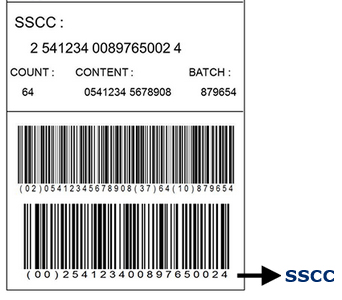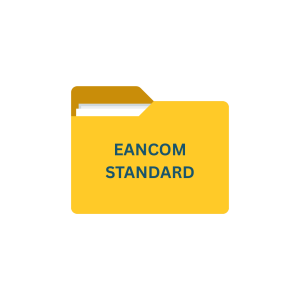Introduction
In the realm of modern commerce, supply chains have evolved into intricate networks that span the globe, connecting suppliers, manufacturers, distributors, and retailers. With such complexity comes the need for robust systems to track and manage the movement of goods seamlessly. This is where the SSCC barcode label steps in – a powerful tool that plays a pivotal role in optimizing supply chain operations and ensuring effective traceability.
Key Takeaways
- SSCC (Serial Shipping Container Code) is a unique barcode label used to identify logistics units like pallets or cartons.
- It enables efficient tracking and management of shipments across the supply chain.
- SSCC labels enhance accuracy, reduce handling errors, and improve visibility in logistics.
- They are widely used in industries for standardized identification, supporting global traceability and inventory management.
- The SSCC barcode is crucial for streamlining shipping, warehousing, and receiving processes.

What is an SSCC Barcode Label?
SSCC stands for Serial Shipping Container Code, and an SSCC barcode label is a unique identification code used to track and trace individual shipping containers or units of trade items within a supply chain.
It is an essential component of the GS1 System, which provides globally recognized standards for various aspects of supply chain management, including identification, communication, and data capture.
The SSCC label is typically represented as a scannable barcode, enabling automated data capture and processing at different points in the supply chain. This barcode contains vital information, such as the manufacturer’s identification, the specific product details, the logistics handling unit (like a pallet or carton) identification, and a unique serial number. This combination of information allows for accurate and efficient tracking throughout the supply chain journey.
Example: SSCC Barcode Label in Action
Imagine a multinational electronics company that manufactures and ships smartphones to retailers worldwide. To ensure smooth supply chain operations and product traceability, the company assigns an SSCC label to each shipping container containing smartphones.
Step 1. Generation of SSCC Label
Before shipping, the company generates an SSCC label for each container using the GS1 standards. The label includes information such as the company’s Global Trade Item Number (GTIN), the serial number of the container, and additional relevant data.
Step 2. Packing and Shipment
The smartphones are carefully packed into containers, each labeled with its unique SSCC label. As these containers move through the supply chain, the SSCC labels allow for easy identification and tracking.
Step 3. Warehouse Management
Upon arrival at a distribution center or warehouse, the SSCC label is scanned, and the information is automatically entered into the inventory management system. This process streamlines the intake process and reduces the chances of errors associated with manual data entry.
Step 4. Retail Distribution
When a retailer places an order for smartphones, the SSCC label on the corresponding container is scanned to confirm the shipment’s contents. This step ensures accurate order fulfillment and minimizes the risk of shipping incorrect products.
Step 5. Point of Sale
The retailer receives the smartphones, and as they are sold to customers, the SSCC label continues to play a role. If there’s a product recall or quality issue, the company can quickly identify affected batches using the SSCC labels and trace the products back to their origin.
SSCC Barcode Label Structure

- Application Identifier (AI)
The AI “00” indicates the SSCC-18 data structure will follow.
- Extension Digit
The Extension Digit has no defined logic and is used to increase the capacity of the Serial Reference
- GS1 Company Prefix
GS1 Company Prefixes are 7-10 digits. Serial Reference Numbers are 6-9 digits.
- Serial Reference
The Serial Reference number is assigned by the holder of the GS1 Company Prefix to uniquely identify a shipping container (logistic unit). A Serial Reference cannot be reused for a minimum of 12 months. The combined length of the GS1 Company Prefix and Serial Reference is always 16 digits.
- Check Digit
Calculated using the Modulo 10 algorithm. Use a free Check Digit Calculator offered by Bar Code Graphics.
SSCC Barcode Print Requirements and Guidelines
- The barcode height must be 1.25 inches.
- Print human-readable numbers above the barcode.
- The barcode must meet the quality standards specified in ANSI X3.182-Bar Code Print Quality Guideline.
- To ensure a 100% first-time rate on all barcodes, test the symbols periodically as print quality can change over time.
- Precede SSCC-18 code with the application identifier “00”.
- Enclose the Application Identifier (AI) in parentheses.
- Mark for Barcode (Final Destination Code)
The Intersection of SSCC Barcode Labels and EDI
EDI serves as the bridge between different entities within a supply chain, enabling them to exchange business documents electronically. These documents include purchase orders, invoices, shipping notices, and more. SSCC labels, on the other hand, provide unique identification for shipping containers and units of trade items. When these two components converge, supply chain operations are optimized for accuracy, speed, and traceability.
1. Generation and Transmission of SSCC Labels
As a shipment is prepared, SSCC labels are generated for each container or logistics handling unit. These labels encode essential information, such as the sender’s and receiver’s identifiers, product details, and unique serial numbers. Through EDI, this information is electronically transmitted to partners along the supply chain, such as manufacturers, distributors, and retailers.
2. Advanced Shipping Notices (ASN)
An ASN is a critical EDI document that provides detailed information about a shipment before it arrives. By incorporating SSCC labels, ASNs become even more informative. Each SSCC label is linked to the products within a shipment, enabling the recipient to anticipate the contents, quantities, and organization of the delivery. This proactive approach streamlines receiving processes and inventory management.
3. Warehouse Management
When the shipment reaches a warehouse or distribution center, the SSCC labels play a pivotal role in EDI-based operations. Upon scanning an SSCC label, the warehouse management system (WMS) automatically updates the inventory database. EDI messages can also be triggered, confirming the receipt of goods and initiating further actions, such as sending invoices or triggering order replenishment.
4. Order Fulfillment and Shipping
As orders are received from retailers, the integration of SSCC labels into EDI enables precise order fulfillment. Retailers can use SSCC labels to verify the accuracy of shipments before they are dispatched. The EDI system can then generate shipping notices and labels, including SSCC data, ensuring that both sides have consistent and accurate information.
5. Product Traceability
In the event of a recall or quality issue, SSCC labels recorded through EDI provide a clear trail of the product’s journey. This traceability aids in identifying affected batches, notifying relevant stakeholders, and minimizing the impact on the supply chain and consumers.
Benefits of SSCC Labels
- Enhanced Traceability: SSCC labels provide end-to-end traceability, allowing companies to quickly identify the origin, movement, and destination of products. This capability is crucial for quality control, recalls, and compliance with regulations.
- Efficient Inventory Management: By automating data capture and entry, SSCC labels streamline inventory management processes. This reduces the risk of errors, improves accuracy, and optimizes stock levels.
- Improved Logistics: The use of SSCC labels enables efficient logistics operations. Transportation and storage are enhanced as containers can be quickly identified and routed to their correct destinations.
- Reduced Costs and Errors: Manual data entry is prone to errors and can be time-consuming. SSCC labels automate this process, reducing errors and associated costs.
- Enhanced Collaboration: SSCC labels facilitate better communication and collaboration among supply chain partners. Each participant can access accurate information about the shipment, leading to smoother operations.
Conclusion
The integration of Serial Shipping Container Code (SSCC) labels and Electronic Data Interchange (EDI) represents a harmonious synergy between physical supply chain processes and digital information exchange. This collaboration empowers businesses to operate efficiently, reduce errors, enhance traceability, and maintain a competitive edge in today’s fast-paced commerce landscape. By embracing the power of SSCC labels within their EDI workflows, organizations can unlock new levels of supply chain optimization and collaboration.
Shipping Labels
The Definitive Guide
The Importance of Shipping Labels & ASN in B2B Commerce
Commport Cloud EDI Solution
Download: EDI Buyers Guide
Unlock the full potential of your supply chain with our comprehensive EDI Buyer's Guide — your first step towards seamless, efficient, and error-free transactions
Frequently Asked Questions
Yes, SSCC barcode labels adhere to international standards set by GS1, ensuring consistency and compatibility across different industries and trading partners. This standardization facilitates seamless communication and interoperability throughout the supply chain network.
Absolutely, SSCC barcode labels are widely accepted for international shipments as they provide a standardized method for tracking and identifying containers regardless of geographical boundaries. They help simplify cross-border logistics processes and enable efficient coordination between global trading partners.
SSCC barcode labels can be generated using specialized software or online tools that assign unique identification numbers and encode them into GS1-128 barcode format. Once generated, the labels can be printed using barcode printers onto adhesive label stock, which is then affixed to shipping containers or pallets prior to shipment.
Utilizing SSCC barcode labels offers several advantages, including increased accuracy in shipment tracking, reduced errors in data entry, enhanced inventory visibility, improved supply chain efficiency, and better compliance with trading partner requirements and industry standards.
An SSCC barcode label typically consists of a 17-digit alphanumeric code encoded in a GS1-128 barcode format. The code comprises a company prefix, unique serial number, and a check digit. Additionally, it may include application identifiers to denote specific information like shipment date or product type.





